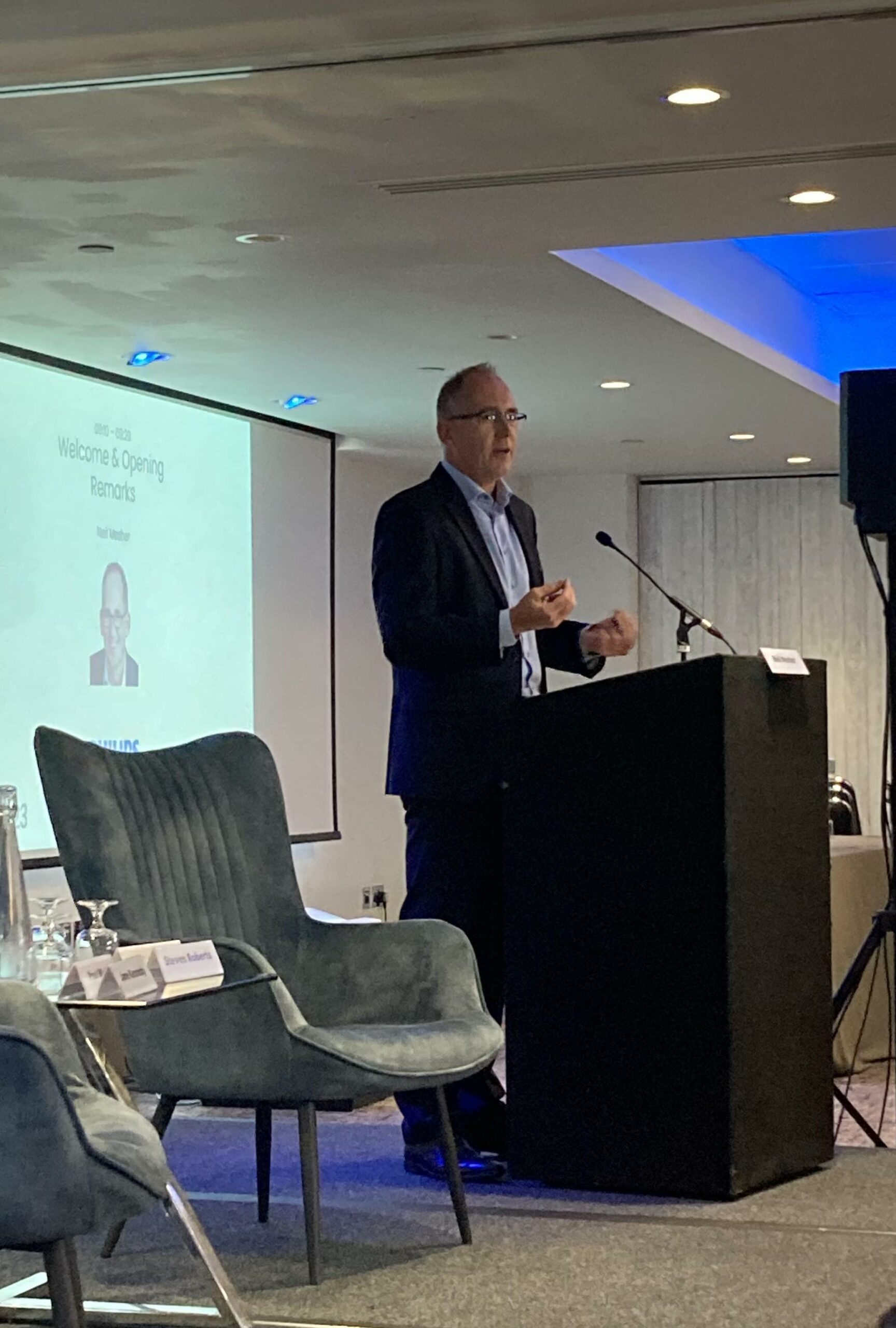“It isn’t possible for those in healthcare to just work harder. Our role as a sector is to help them work smarter.”
In its fifth year running, fresh with re-branding and renewed support from event partners ABHI & CPI, Neil Mesher (Senior Vice President, Philips, Western Europe, Chair, ABHI), opened HealthTech Integrates 2023 by expressing his delight to be at a UK HealthTech event with over 300 registered delegates.
“Networking is critically important for us to address the challenges and opportunities within the HealthTech space going forward,” he said, praising the depth of the agenda in which industry insiders shared advice, insights, and experience across each stage of the HealthTech pipeline, from research through to funding, regulations, and market access.
“We meet in interesting times,” began Neil, describing the current financial climate and the challenges of a healthcare service grappling with the pandemic backlog combined with workforce shortages and industrial action. “But despite of – and indeed because of – these challenges, there are opportunities for the HealthTech sector,” he said, explaining the potential for HealthTech innovation to drive down costs, improve clinician and patient experience, and ultimately facilitate better patient outcomes: “it isn’t possible for those in healthcare to just work harder. Our role as a sector is to help them work smarter.” Neil outlined the agenda, with two exclusive fireside chats and 13 expert panel discussions covering ‘Promise’, ‘Purpose’, and ‘Potential’, complemented by wide-ranging industry exhibitions and a HealthTech Innovator Area.
“We re-invented the culture within an organisation. We learnt to be humble, we learnt to listen.”
Fireside Chats
With finance high on the public agenda, the sessions began with an eye-opening interview with Barclays UK’s Head of Culture & Transformation & Chief Scientific Advisor Steven Roberts, conducted by Jane Kennedy, Chief Business Officer at Discovery Park. Steve outlined Barclays’ award-winning Eagle Lab scheme – a network of 35 tech innovation labs across the UK, forming the largest tech incubator network in Europe.
“We rediscovered what being a bank was about,” he said, explaining the development of the Eagle Labs from ‘maker spaces’ to the tech innovation hub they’ve become today. “As they developed, we experimented. We listened to what people wanted. We worked with third parties to provide services that support funding, scale-up, and connection.”
Delving into why people were paying to work in Eagle Labs over cheaper alternatives, Steve shared the answer he got from lab-users: “it’s because of the network you can connect us to.”
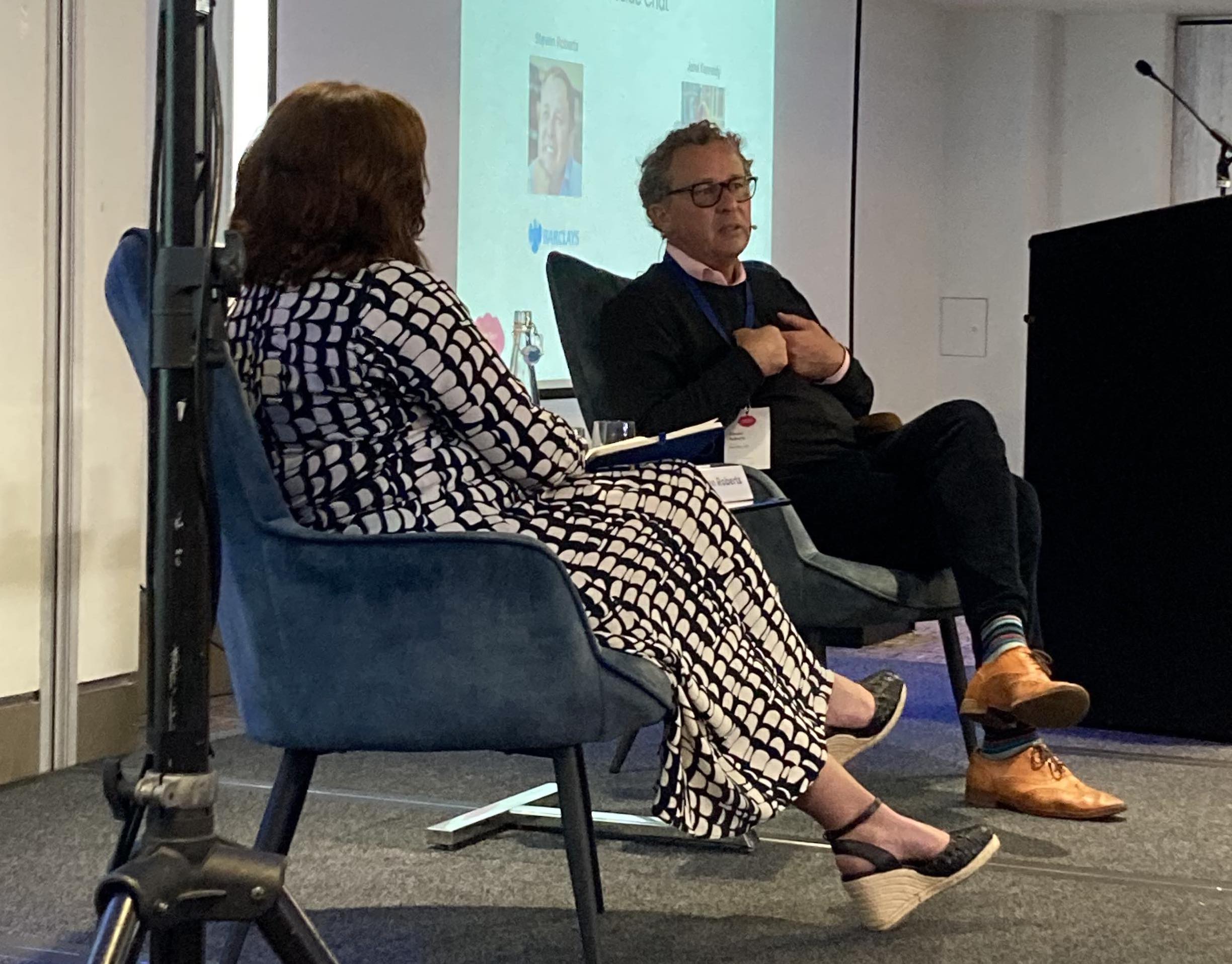
Steven Roberts | Chief Scientific Advisor | Barclays UK
Interviewed by
Jane Kennedy | Chief Business Officer | Discovery Park
“If you have a daughter, call her clever not pretty, give her science books not fairy tales.”
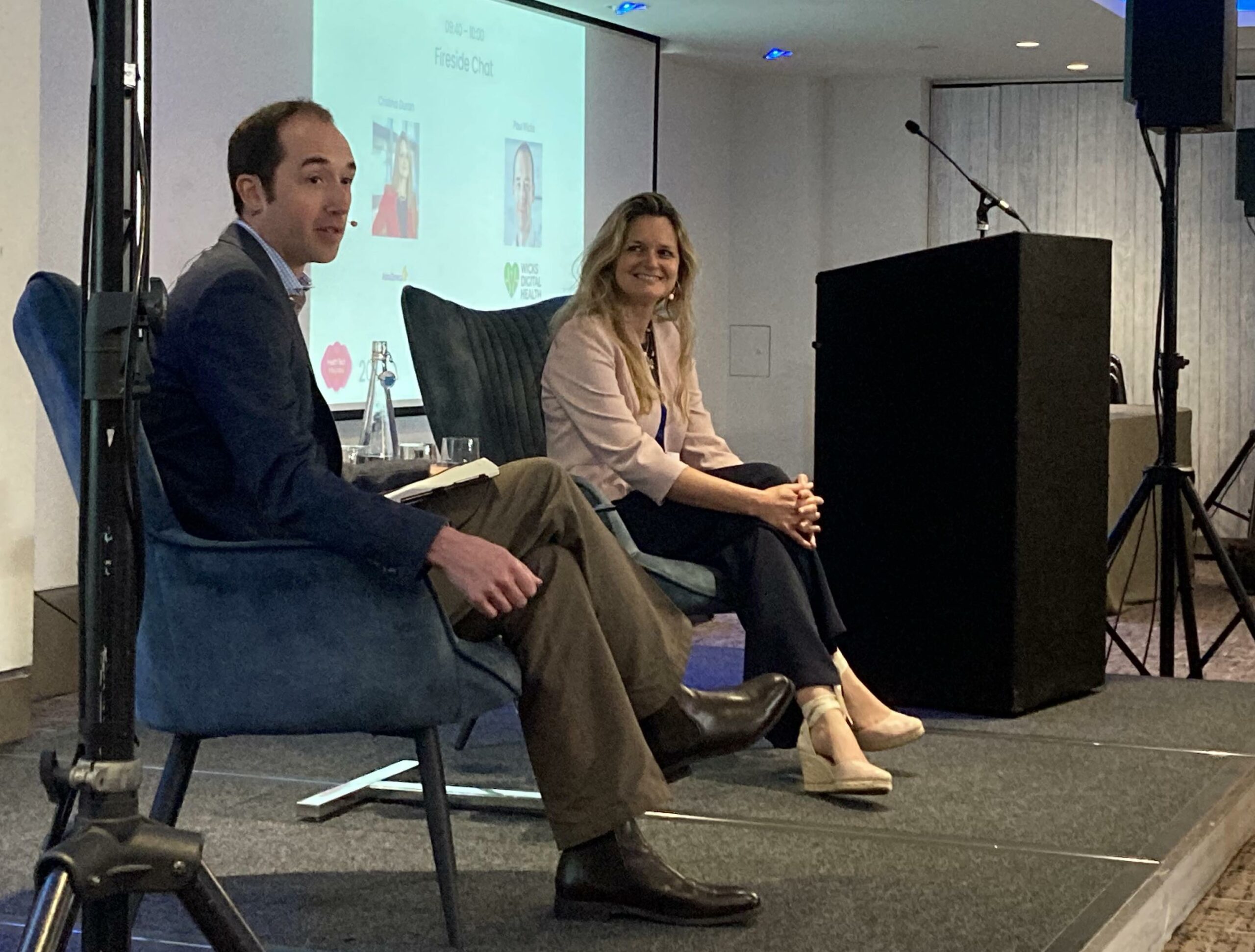
Cristina Duran | Chief Digital Health Officer, R&D | AstraZeneca
Interviewed by
Paul Wicks | Independent Consultant | Wicks Digital Health
“If you have a daughter, call her clever not pretty, give her science books not fairy tales.”
Turning from the reinvented culture of a bank to the ever-evolving culture of big pharma, the second fireside chat featured AstraZeneca’s Chief Digital Health Officer, R&D, Cristina Duran, interviewed by Paul Wicks, Independent Consultant, Wicks Digital Health. With 14 years at AstraZeneca, Cristina described the company’s digital transformation.
“Our digital journey started slightly later than other pharma companies, but rather than making huge claims that we were going to ‘solve it all’, we did it on the quiet. We ran digital pilot projects and looked carefully at how we could scale innovation. We can’t get complacent.”
Discussing common problems in digital innovation, Cristina emphasised the importance of simplification.
“If you look at the technology available, there are loads of possible solutions that could be applied to a problem, but then you’d end up with a whole suitcase of devices that you have to give to each patient. As a sector, we need to solve this complexity and unify the solutions so that we don’t end up giving a patient 12 devices with 12 logins.”
Paul ended the conversation by asking Cristina to share an anecdote about a recent experience with Lego:
‘I was playing with Lego with my son when he was 5, and I picked up a female figure and said “I’m the boss.”
‘My son said “no! You can’t be a boss, in the Lego movies, the BOY is always the boss”.
‘I realised how many subliminal messages there are in books and films about gender, colour, background, etc. that influence how our children think.
‘I worked hard to change this, and 5 years later, I asked him to pick a figure of a boss from the Lego set. Again, he got a man that looked like the hero in the Lego movie. In 5 years, nothing had changed. He did admit that it ‘could’ have been a female this time, but still the influence of the movie was the strongest.
‘My message to you is, if you have a daughter, call her clever not pretty, give her science books not fairy tales.’
The three Ps for panel discussions
The panel sessions covered three tracks to address the challenges which are needed to overcome in the HealthTech community, to achieve a transformation of diagnostics and devices in healthcare:
Promise, Purpose & Potential
Track 1: Promise
“The NHS has excellent research – where it falls down is in the implementation. There’s a translational gap. Fundamentally, it needs more money.”
– Session 1, ‘Lighting the way’
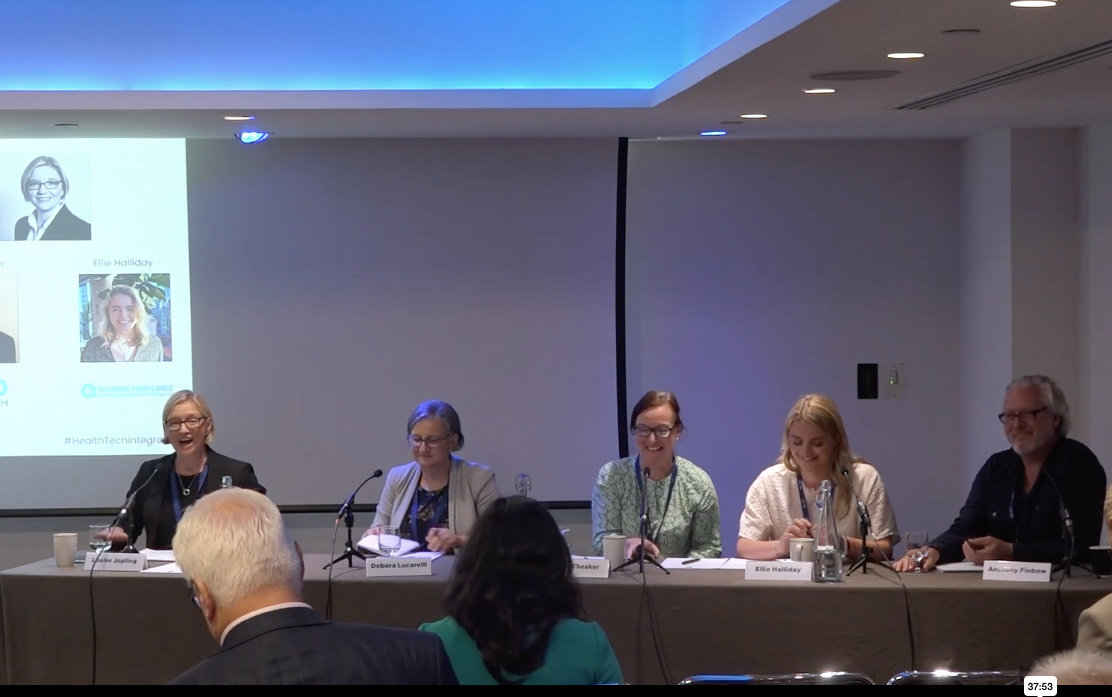
FACILITATED BY
Louise Jopling | Commercial Director | Eastern Academic Health Science Network
PANELLISTS
Debora Lucarelli | Chief Executive Officer | Enhanc3D Genomics
Jane Theaker | Chief Executive Officer | PBD Biotech
Ellie Halliday | Data Privacy & Compliance Manager | Talking Medicines
Anthony Finbow | Chief Executive Officer | Eagle Genomics
With advances in fields such as RWD, omics, imaging, and Dx, Louise Jopling discussed the potential for moving the dial towards disease interception, prevention, and very early detection.
“Moving funding upstream towards diagnostics is difficult – it’s like trying to turn around an oil tanker,” said Jane Theaker, as speakers discussed challenges around costs, implementing change in the NHS, and wider issues of equality.
Solving inequalities in health literacy requires clear communication of the benefits of early diagnosis and prevention, said Ellie Halliday: “there’s a massive disparity between the way in which patients communities communicate versus how healthcare professionals communicate.”
Sharing optimism, panellists praised the supportive efforts of key players in the UK. “Despite the challenges, we’re seeing government policy moving upstream towards better diagnostics and disease prevention,” said Anthony Finbow. “There are many organisations in the UK doing all they can to support precision medicine,” added Debora Lucarelli, “the next step is to find a way to utilise the data that’s being generated.”
“Of the top 10 risks facing us over the next 10 years, 2 of them are related to the environment.”
– Session 2, ‘Cleaner future?’
With an ever-growing urgency to reach Net Zero, Martin Baxter asked how HealthTech is embracing sustainability, covering single-use plastics and the carbon costs of data processing.
“The NHS was the world’s first health system to commit to Net Zero – we’re at the forefront and trying to spearhead the change,” said Michelle Sullivan. “90% of our emissions are out of our direct control so we’ve been working on the 10%. But now we need to focus on the 90% – the will is there, but we’re looking for the way.”
Discussing sector-specific challenges, Addie MacGregor mentioned regulation: “a major challenge is that changing any material means you may have to go through the entire regulatory process again. This takes time and money.” Brennan Miles outlined the recycling challenges: “many medical devices contain several different materials that are not designed to be taken apart, so they’re difficult to reuse or recycle.” Sustainability needs to be built into a product right from the start, he explained.
Looking to solutions, Daniel Coole discussed the application of circular economy principles in a healthcare setting. “We need to change our mindset to become a nation of fixers – we need to build this into technical skills in schools,” he said. Pete Waddingham mentioned the potential for technology to improve carbon accounting: “people need better data available to spot the opportunities for improvement. Enabling technologies like AI have potential to make things easier.” Sharing the big picture view, Addie reminded delegates that HealthTech itself has the potential to make healthcare more sustainable: “investing in prevention and diagnostics is better for people, the planet, and the population.”
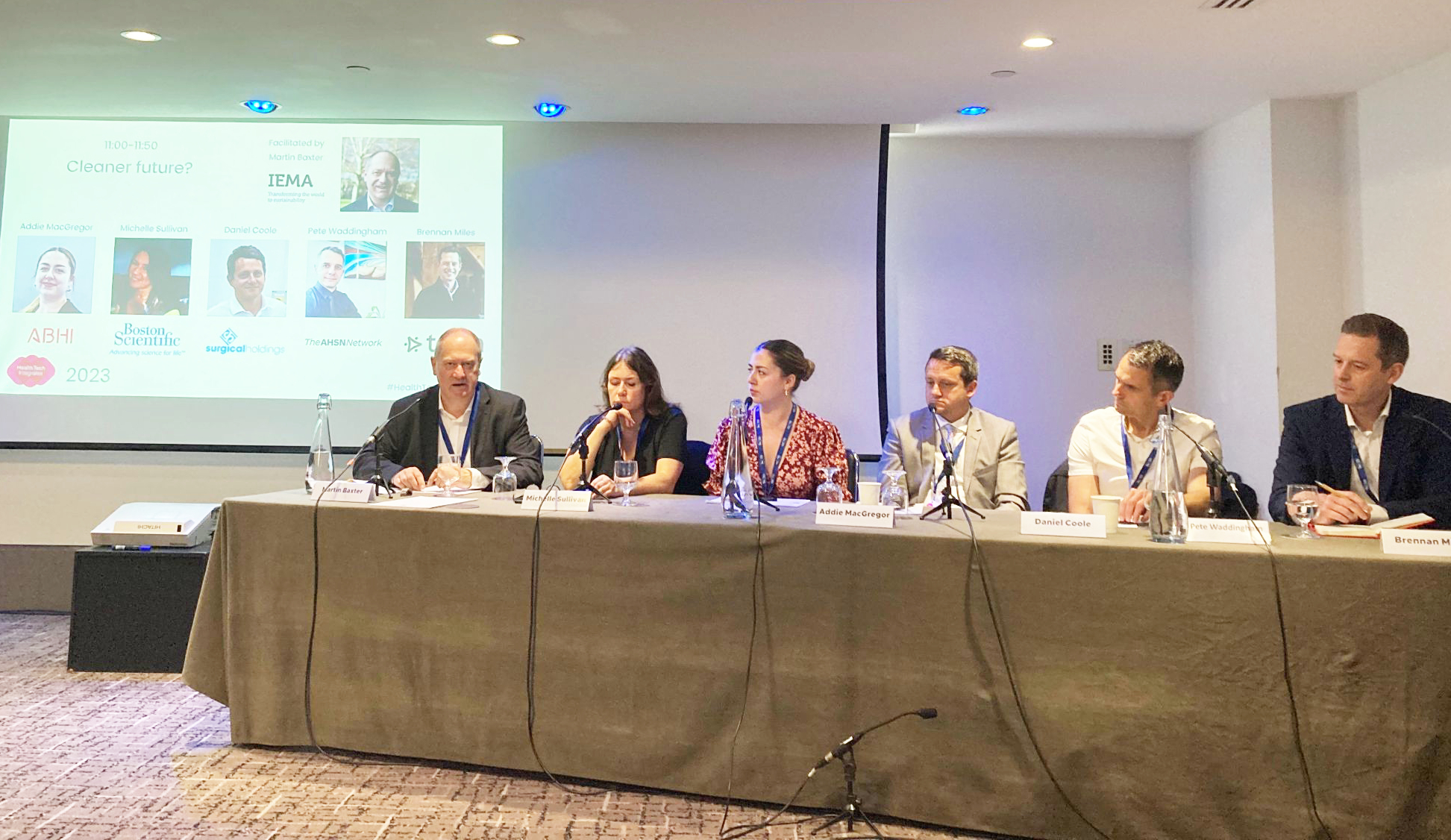
FACILITATED BY
Martin Baxter | Chief Executive Officer | IEMA
PANELLISTS
Addie MacGregor | Sustainability Executive | ABHI
Michelle Sullivan | Head Of Public Affairs | Boston Scientific
Daniel Coole | Managing Director | Surgical Holdings
Brennan Miles | Head of Drug Delivery | Team Consulting
Pete Waddingham | National NetZero Lead | The AHSN Network
“The NHS is pushed. We need to upskill NHS staff to ensure they’re receptive to innovation.”
– Session 3, ‘Wear’s my data?’
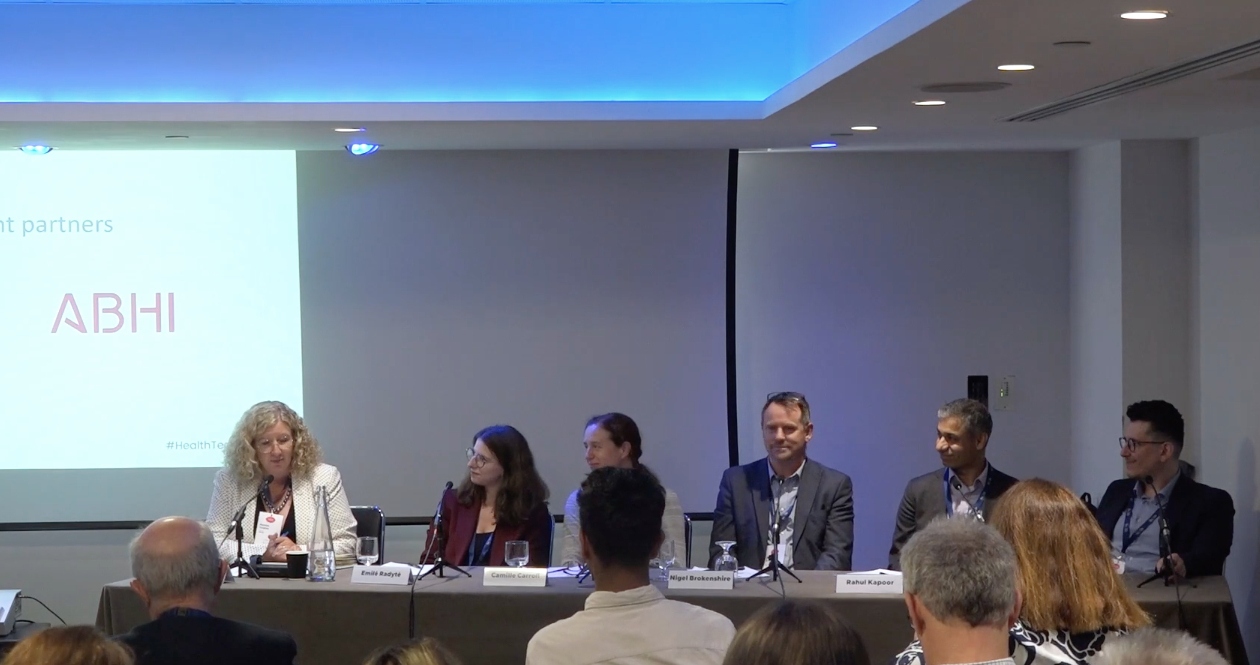
FACILITATED BY
Beverley Vaughan | Innovation Hubs Director | ARISE
PANELLISTS
Emilė Radytė | Co-founder & CEO | Samphire Neuroscience
Camille Carroll | Honorary Consultant Neurologist | Plymouth Hospitals NHS Trust
Nigel Brokenshire | Head of Digital Healthcare UK/I | Bayer PLC
Rahul Kapoor | Director of Health Tech | CPI
Luca Lipani | Co-Founder & Chief Executive Officer | Transdermal Diagnostics
With the multiple owners and multiple formats of data from wearable devices, Beverley Vaughan asked what actionable value can be achieved from wearables data.
Camille Carroll spoke about navigating the opportunity for large-scale change while avoiding risks of data biases and healthcare inequalities: “it’s attainable but we need to work out how to break down barriers to data sharing and how to collect data from different communities.”
This approach takes time, commented Nigel Brokenshire: “take time to define the problem, don’t jump to a solution.”
With diverse applications of wearables, panellists shared unique insights from the fields of women’s health and diabetes. Co-founder & CEO of a women’s health wearables company, Emilė Radytė outlined issues surrounding data gaps and privacy. “There are often no records of menstrual cycle stages, even though this could impact treatment and outcomes. Also concerns surrounding Roe vs Wade cause worries about data privacy.” Luca Lipani gave insights from diabetes: “there are huge health inequalities in Type 2 Diabetes. We need an affordable solution that’s accessible to everyone.”
Taking a broader perspective, Rahul Kapoor shared a message of optimism: “the UK is among the best markets for digital healthcare. We have pockets of great innovation; we have pockets of good data sets. The challenge is in the connectivity required for scalability.”
“Manufacturers need to get to regulators now and not leave it to the last minute. Do it now.”
– Session 4, ‘Navigating the regulatory pathway’
With different regulatory pathways in the US, EU, & UK, Hugh Harvey asked how to select the best pathway, and how to prepare a successful regulatory strategy.
As entrepreneurs in digital therapeutics, Ema Kufel and Ama Frimpong shared their insights from dealing with UK regulations. “Our goal is to get devices in patients’ hands. The UK market is not worth the risk right now because it’s not clear how much the situation surrounding regulations and standards will change,” said Ema.
Ama spoke of a similar dilemma: “it’s a dilemma whether to go for UK approval. We’re doing clinical trials here, but it’s not clear what they want from us. We’re preparing for the direction we think regulations are going to go, but it could change. We want to be in the UK so we can help people here, but it’s difficult. We need people to fix it.”
Comparing different markets, panellists praised the US, but didn’t discount the UK. “Anecdotally we’re seeing a drift to the US, and the size of the potential market is driving this,” said James Fry. He praised the FDA’s proactive approach in taking innovative devices through the regulatory pathway.
Mina Frost also praised the FDA. “In my experience, the FDA is more open-minded and gives more help. I’m not surprised we’re seeing manufacturers shift to the US. The UK needs to show agility in the framework to attract and retain companies.”
“I agree that we’ve seen a shift to the US – the market share is 10x bigger,” added Vishal Thakker. “But at the same time, there’s also a shift of innovative device manufacturers leaving the EU and coming to the UK because it’s currently easy to gather the data to meet UK regulations.”
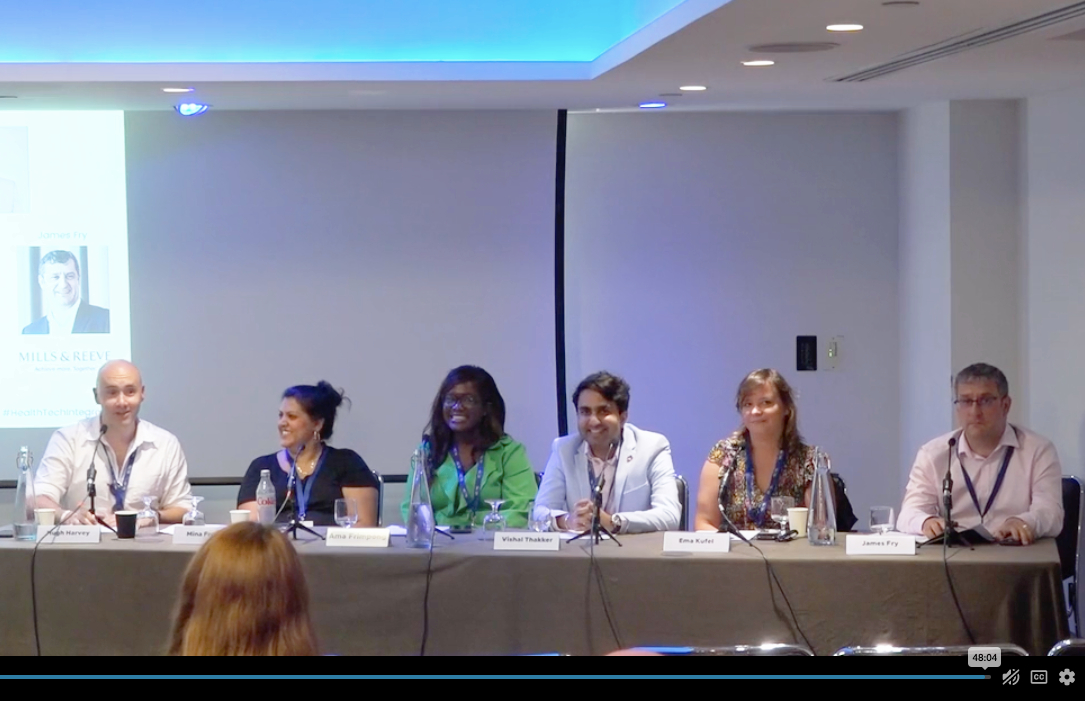
FACILITATED BY
Hugh Harvey | Managing Director | Hardian Health
PANELLISTS INCLUDE
Mina Frost | Founder & Director | Decode X
Ama Frimpong | Head of Product Development | 52 North Health
Vishal Thakker | Head of UK Approved Body & Senior Regulatory Lead | British Standards Institution (BSI)
Ema Kufel | Co-founder & UK Chief Executive Officer | Prosoma
James Fry | Partner and Head of Life Sciences | Mills & Reeve
“Before the pandemic, diagnostics was a black box, it wasn’t as ‘cool’ as pharma.”
– Session 5, ‘The brightest and the best’
Pari Datta asked diagnostics experts how we can build on our learnings from the pandemic.
“Pre pandemic there was a slight dislike towards diagnostics – it was a dirty word. Then in the pandemic it became a sexy subject, people were investing,” said Robert Porter, reflecting on how the pandemic changed attitudes towards diagnostics. “It brought the people who didn’t normally use diagnostics into the fray.”
“Consumer behaviour is the biggest change,” added Frederick Manduca, “the public understood what the results meant and what the next steps were.”
Looking at what’s been learnt – or not – from the pandemic, the panellists were not wholly optimistic as to whether the field has moved forward. “At the start of the pandemic people underestimated how difficult it was to do diagnostics. There were huge supply chain problems. We built up some capacity, but forgetting this isn’t helpful for the next time we need large numbers of diagnostics on shelves. And we are forgetting,” said John Tyson.
Speakers shared concerns about the UK’s diagnostic market. “The UK has the brightest and best scientists in diagnostics, but they’re underfunded and underappreciated. Because the devices look so simple we assume they’re easy to make, but in reality it’s extremely complex,” said Robert.
“All of our tests are being manufactured overseas – it’s a sad state of affairs for British diagnostics coming out of Covid,” added Frederick.
Looking to solutions to support the diagnostics market, Jonathan O’Halloran emphasised the need for money, procurement, and regulation: “we need to change NHS procurement rules because they’re biased to large companies which are mostly overseas.” And, however the diagnostics market evolves, Peter Whawell emphasised the importance of building speed into system: “when it comes to communicable pathogens, we’re in a race. We need to find the infected person before they’re infectious. We have to have a plan that will win that race.”
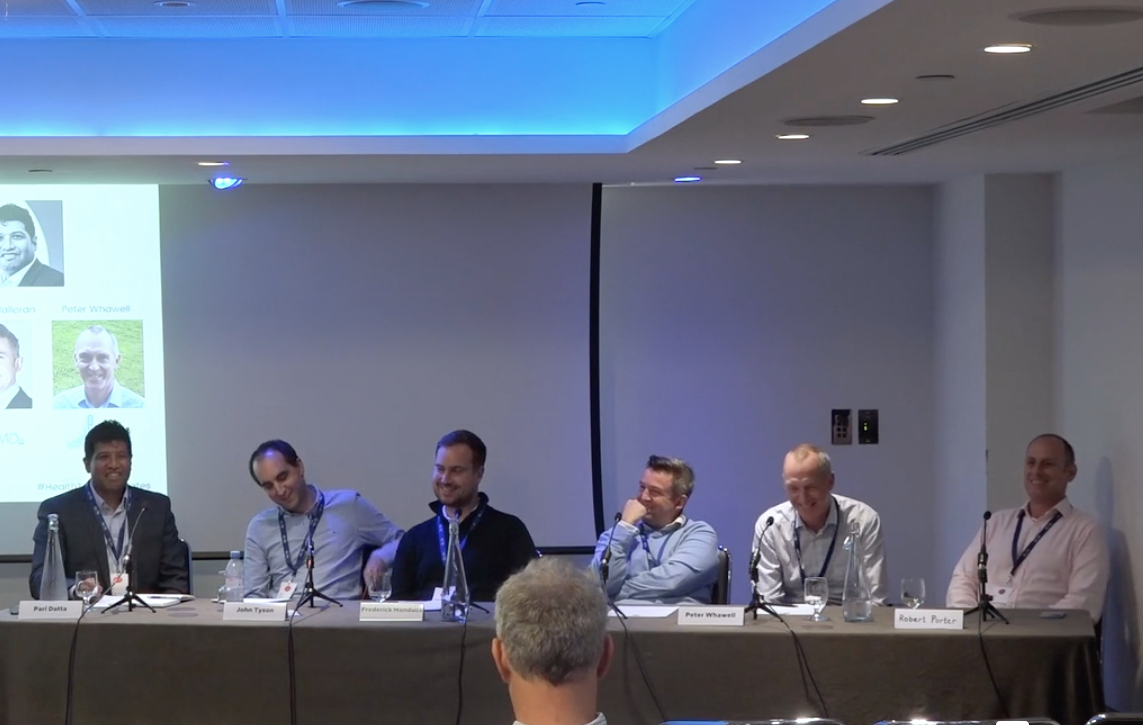
FACILITATED BY
Pari Datta | Principle Consultant – Strategy/Diagnostics & Life Sciences | Cambridge Design Partnership
PANELLISTS
John Tyson | Head of the North East Innovation Lab | Newcastle Upon Tyne Hospitals NHS Foundation Trust
Frederick Manduca | Director | Newfoundland Diagnostics
Jonathan O’Halloran | Chief Executive Officer | QuantuMDx Group
Peter Whawell | Chief Executive Officer | Proxximos
Robert Porter | Chief Executive Officer | RAPIvD
Track 2: Purpose
“Don’t talk about data as ‘the new oil’, but talk about data saving lives.”
– Session 2: ‘Picking the right door’
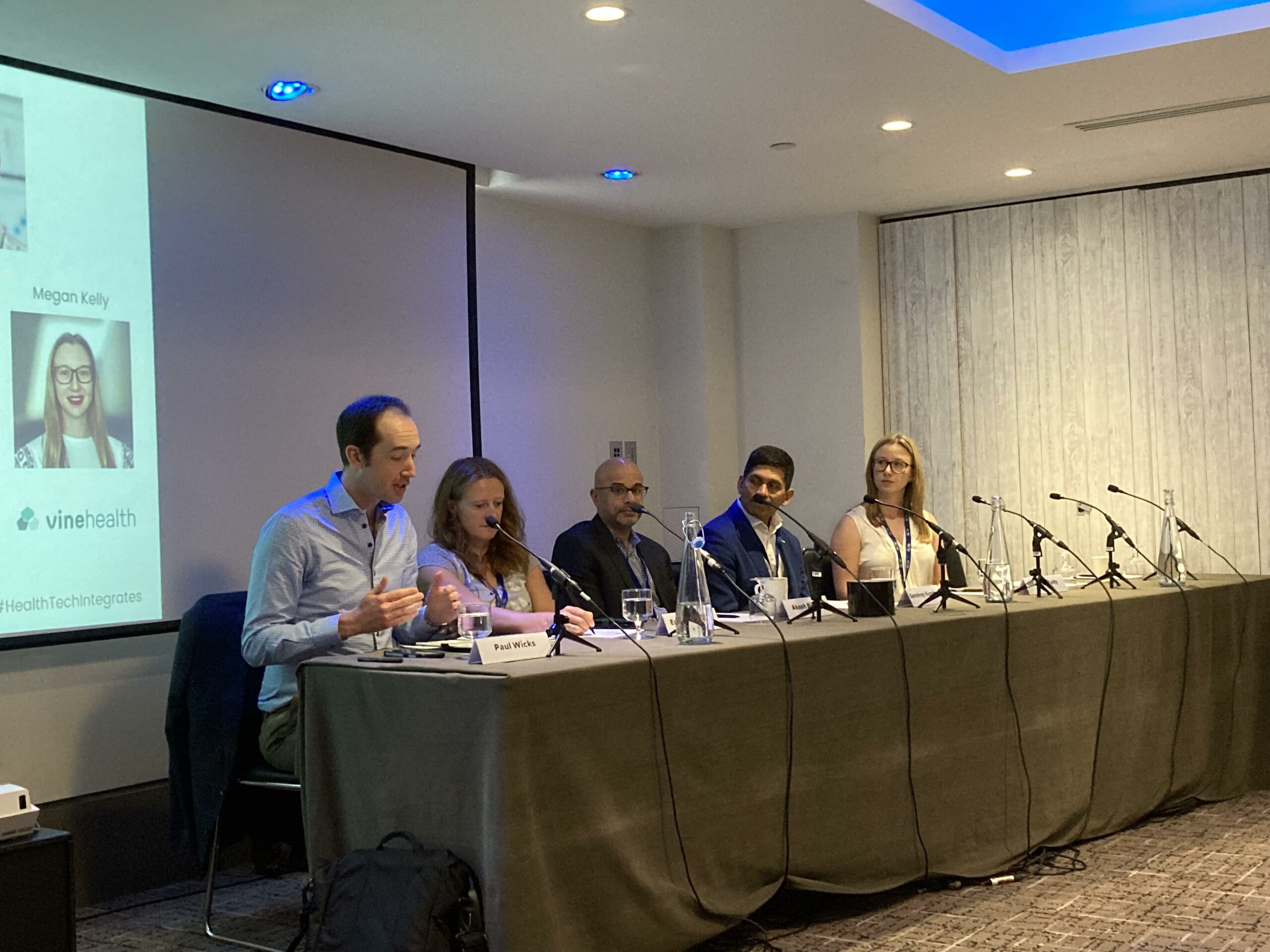
FACILITATED BY
Paul Wicks | Independent Consultant | Wicks Digital Health
PANELLISTS
Emily Jefferson | Chief Technology Officer | Health Data Research UK
Akash Bijlani | Director, Global Market Access | Aptar Digital Health
Sandeep Konduru | Founding CEO | REMCARE
Megan Kelly | Solutions Delivery Manager | Vinehealth
With significant differences between UK, European and US markets, Paul Wicks asked how we speed up market access and adoption by healthcare providers.
“We need to address challenges surrounding regulations, data privacy, resistance to change, and a fragmented market that makes it difficult to scale-up,” said Megan Kelly. Exploring this fragmented market, panellists discussed differences between key global locations.
“The UK is a complex market, but compared to the convoluted system of the US, it has the big benefit that we have a single healthcare system, the NHS. This means the pathway is more streamlined,” said Akash Bijlani.
A key discussion point was access to clinicians, and Sandeep Konduru advocated to take a clinician’s perspective: “they have so many systems, so many logins, they don’t want another system. Speak to the clinicians and understand their workflow so you can provide a customised solution to address their pain-points.” Expanding on these ‘pain-points’, Sandeep mentioned the lack of structured data in the NHS. “The data in the NHS is notoriously badly coded, messy, and takes an inordinate amount of time to clean up,” agreed Emily Jefferson, calling for processes to curate and present back data to immediately highlight any errors. “There are huge inefficiencies across the whole system,” she said.
“What regulations come down to is ‘good science and good engineering done consistently with the aim of enhancing and improving the lives of people.’
– Session 3, ‘Spotlight on the regulators’
With regulations becoming ever more encompassing – and made increasingly complex by the fine line between ‘digital health products’ and ‘medical devices’ – James Fry asked whether regulations are keeping pace with innovation.
The panel compared UK, US, and European regulatory scenes. “The UK’s an attractive place for innovation. It’s a great place for development. But it’s challenging to get innovations adopted,” said Michael Kipping. “The FDA are consistent and predictable – that’s what manufacturers need from a regulator,” he added. Timothy Bubb also praised the FDA: “there have been a number of reforms that have made interactions with the FDA much more meaningful. We need to learn from this system and think about how we can help innovators.”
The key message was the importance of early engagement with regulators. “We work with manufacturers to help them reach an early understanding of how they can incorporate clinical safety and risk assessments into those very early conversations with clinical users,” said Paul Weston. “It’s about engaging with the regulators from the beginning, that’s the key for manufacturers of medical devices,” added Vishal Thakker. “Engage from the beginning, and they will help you navigate the key milestones.”
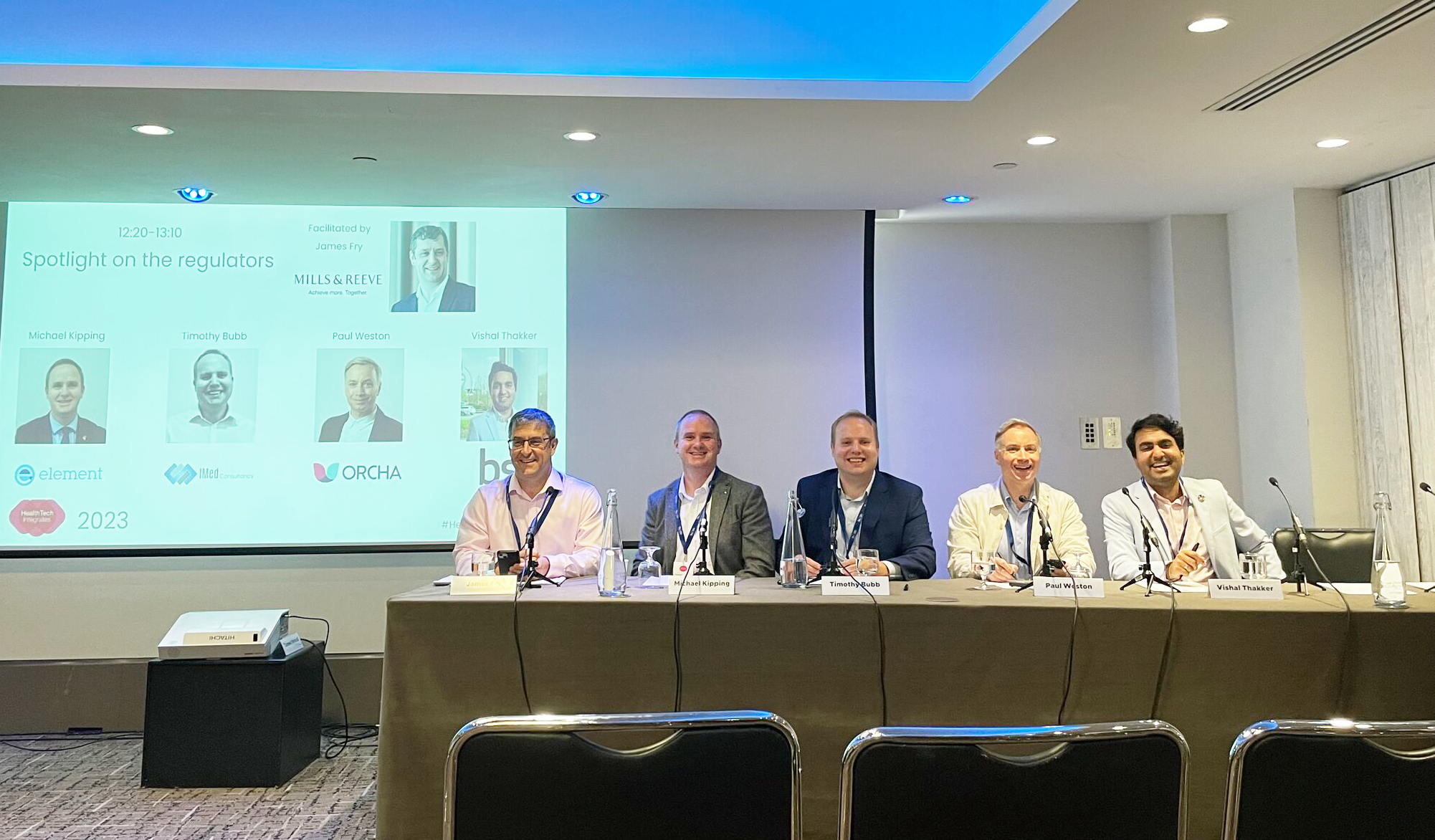
FACILITATED BY
James Fry | Partner and Head of Life Sciences | Mills & Reeve
PANELLISTS
Michael Kipping | Director, Medical Technologies EMEAA | Element Materials Testing
Timothy Bubb | Technical Director | IMed Consultancy
Paul Weston | Review & Accreditations Director | ORCHA
Vishal Thakker | Head of UK Approved Body & Senior Regulatory Lead | British Standards Institution (BSI)
“Up to 16% of our population is unable to access the internet or use it effectively.”
– Session 4, ‘Realising the value of wellness’
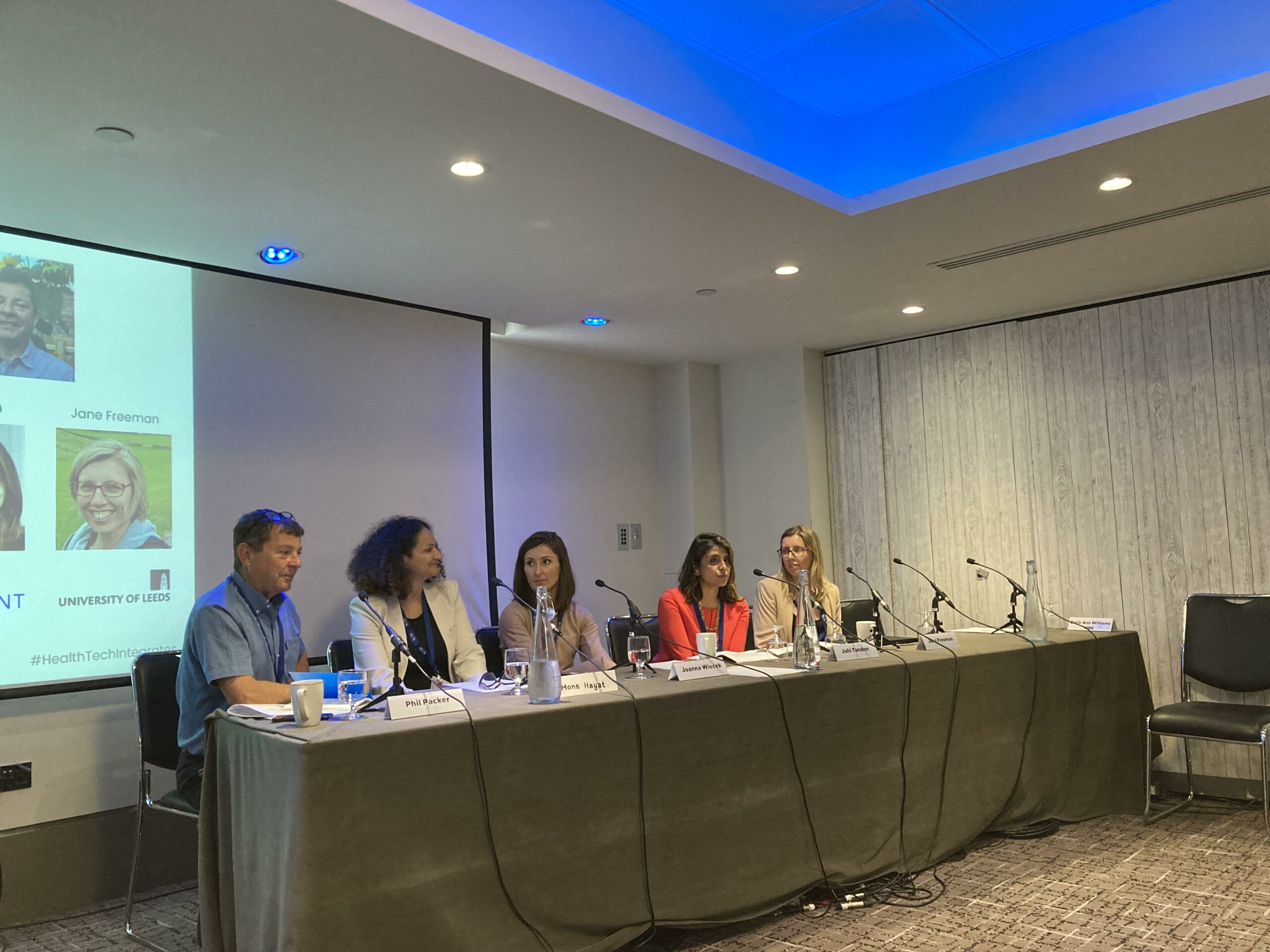
FACILITATED BY
Phil Packer | Innovation Lead AMR and Vaccines, | Innovate UK
PANELLISTS
Joanna Wiecek | Chief Scientific Officer | CircaGene
Juhi Tandon | Medical Director | Cognitant
Mona Hayat | Founder & Chief Executive Officer | Nexus Digital Technology
Jane Freeman | Associate Prof in Clinical Microbiology | University of Leeds
With enhanced diagnostics, early detection, and better understanding of disease, Phil Packer asked whether HealthTech will facilitate a shift towards preventative healthcare. “Treating people who are ill is suboptimal,” began Mona Hayat. “The NHS has been trying to drive forward prevention, but in reality we haven’t achieved it. It’s not just about preventing long term diseases, but signposting people into healthcare when they actually need it.”
Joanna Wiecek shared a similar view, commenting on the potential for a preventative health system to save both lives and money. “There’s huge potential in digital technology, biotech therapies, gene therapies – but we need to have access to patient records, and currently only 10% of NHS trusts actually have electronic records.”
Reflecting on the evolution of the NHS 75 years on from its establishment, Juhi Tandon explained how the patient population is different from 1948: “we have a diverse and aging population with many rapidly evolving conditions we don’t fully understand.”
“Our populations are ever more susceptible to infections because we’re older and we can better treat diseases that leave people vulnerable to infection,” added Jane Freeman, who outlined how development of point-of-care tests could improve speed and accuracy of infection diagnoses, with huge benefits in the battle against antimicrobial resistance. Looking to a solution, Juhi called for patient education: “we need more investment in educating and empowering patients so they can better manage their health. We must upskill patients in digital technologies so that no one is left behind.”
“Before you scale you’ve got to have the right foundations in place. Nail it to scale it.”
– Session 5, ‘Getting to the market’
Your commercialisation strategy has the potential to make or break you, and Neil Ebenezer discussed partnering strategies and the pros and cons of different global markets. “Find the right partners at the right time,” advocated Steven Bagshaw, “surround yourself with people who can complement your weaknesses.”
Comparing UK and US markets, John Milad shared his perspective as an investor: “the UK serves as a great sandbox to test businesses, but it’s not a big enough marketplace to be an end market itself. Investors are looking for clear plans to go into the US as that’s where the biggest market is.”
Matt West agreed: “there’s a lot of opportunity in the UK – take those successes and replicate across other systems.” Considering the US market, he advised to choose your landing spot: “the US is so big, think about where you want to land.”
One of the biggest challenges in accessing different markets is differences in regulations. “The MHRA need to closely align with FDA for medical devices. This would help UK businesses to reach the US market,” said Meri Beckwith. “My one magic wand to solve the barriers? Merge the MHRA and the FDA.”
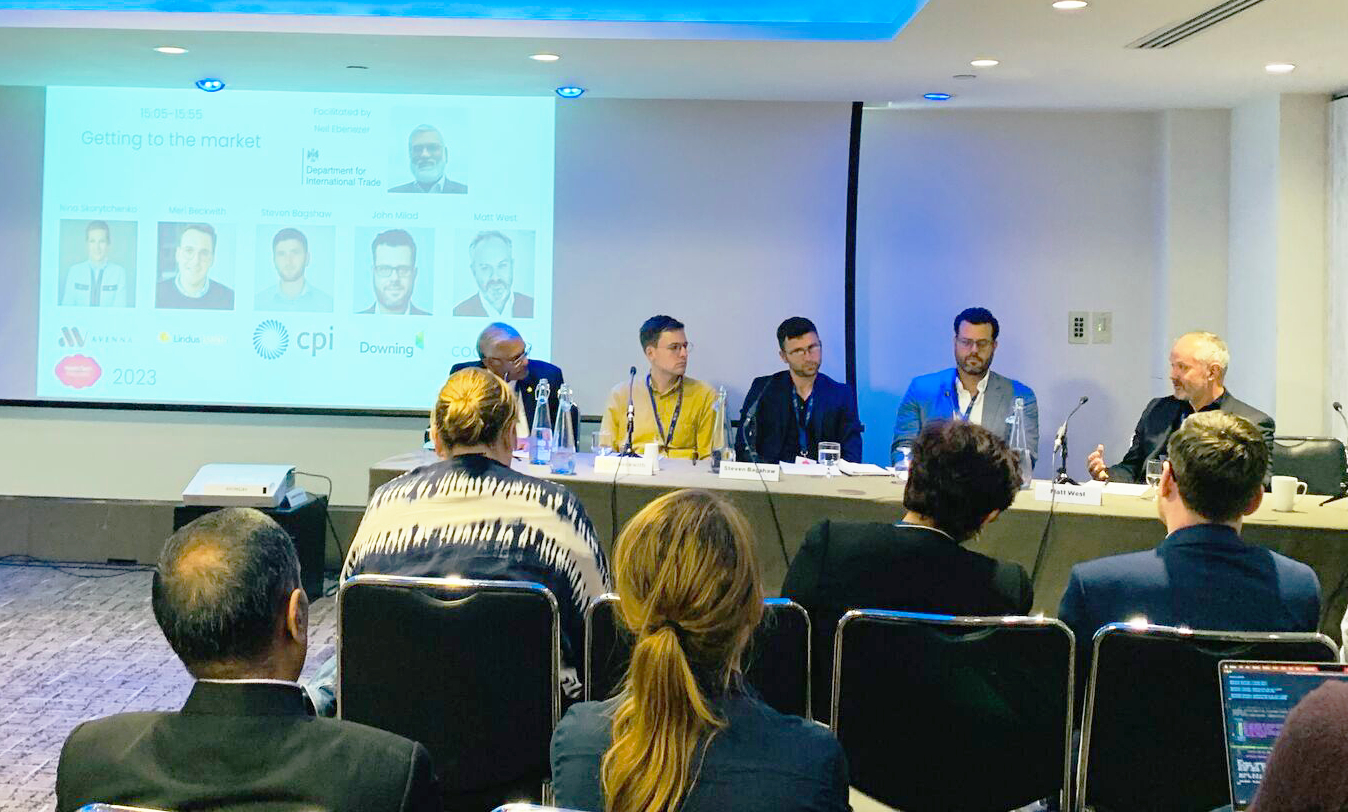
FACILITATED BY
Neil Ebenezer | Medical Technologist Specialist, | Department for International Trade
PANELLISTS
Meri Beckwith | Co-founder | Lindus Health
Steven Bagshaw | Head of Business Strategy | CPI
John Milad | Partner & Co-Head of Healthcare Ventures | Downing
Matt West | Chief Commercial Officer | Cognitant
Track 3: Potential
“The little pieces of advice that people give you along the way REALLY matter down the line. Keep doing the little things.”
– Session 1, ‘Starting with the end in mind’
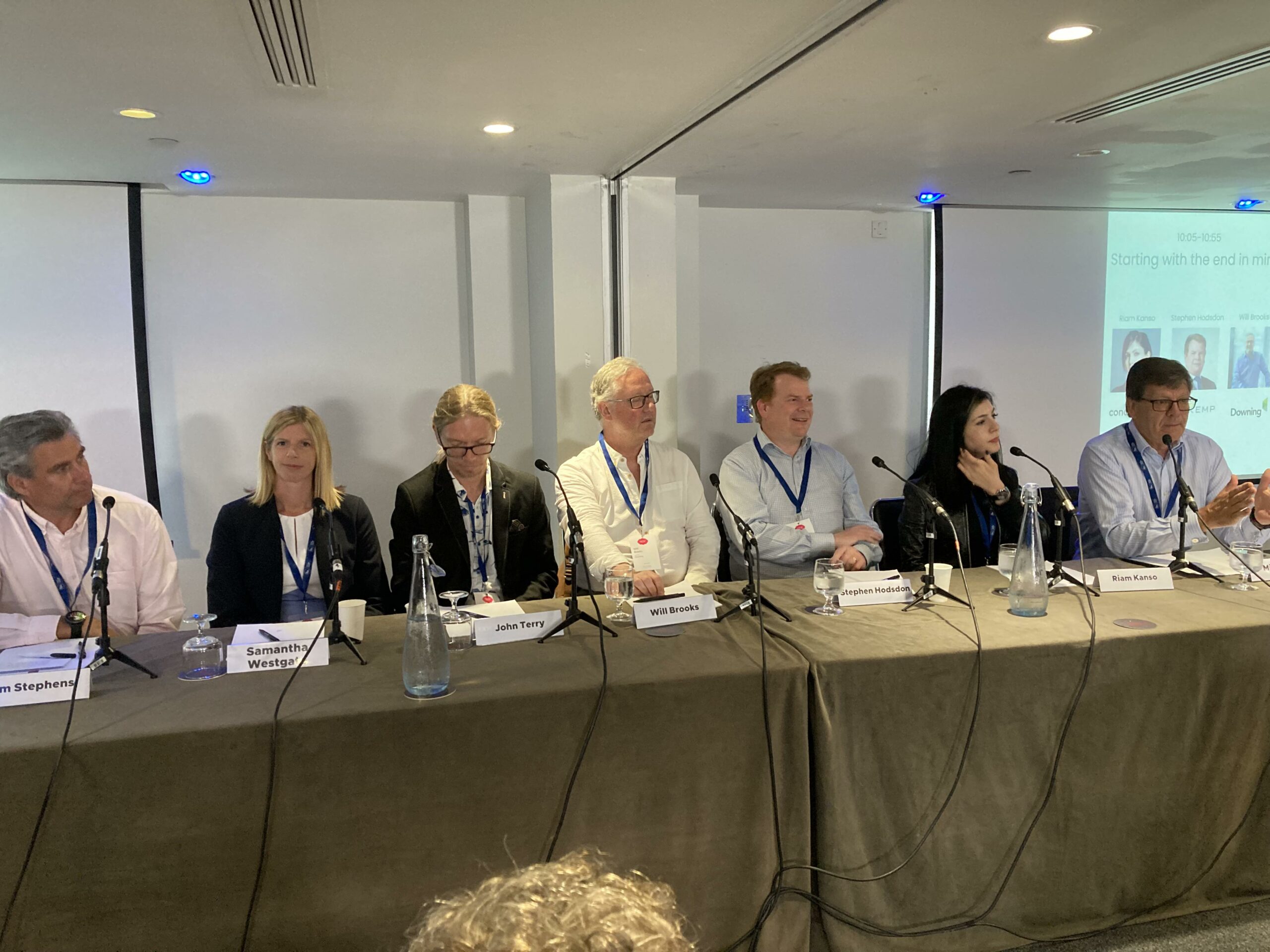
FACILITATED BY
Michael Lewis | Scientific Director for Innovation | NIHR
PANELLISTS
Riam Kanso | Founder & Chief Executive Officer | Conception X
Stephen Hodsdon | Partner | J A Kemp
Will Brooks | Investment Director | Downing
John Terry | Managing Director | Neuronostics
Samantha Westgate | Chief Executive Officer | Perfectus Biomed Group
Sam Stephens | Director | TBAT Innovation Ltd
In a competitive market, funding is hard won, and Michael Lewis asked how to set up for success. A key message was the need for education around IP.
“It’s never too early to think about IP,” said Stephen Hodsdon, sharing his legal perspective. “Thinking about IP from an early stage gives you a much better idea of your strategy going forward. Even if you just do the thinking, you’re already ahead of 75% of companies in the sector.”
John Terry agreed, emphasising the importance of educating the research community about opportunities surrounding IP protection and common challenges that could counter disclosure: “Align the values of the institution alongside the aspirations of the individual.”
Working with PhD students, Riam Kanso highlighted the importance of choosing the right investor: “I tell my entrepreneurs to look for not just money but support from the VC. It’s a long journey, so having funders who understand is important.” Adding an investor’s point of view, Will Brooks spoke of balancing expectation with reality: “balance your enthusiasm for what you’re doing with your realism about what you can achieve.”
The session ended with tips for entrepreneurs. “Be aware that you may not be the best person to run your business,” warned Sam Stephens. “Whatever you can do to have the best people in your team, do it,” advised Samantha Westgate, advocating for flexible working arrangements.
“Work with patients from the very beginning.”
– Session 2, ‘Is there an app for that?’
“Apps in healthcare are growing more than in any other area. There’s a medical app boom, but is this a good thing? Is it sustainable?” asked Monica Fletcher OBE.
Commenting on this huge number of apps, Lloyd Humphreys mentioned the benefit of choice. “We need choice because there’s not a one-size-fits-all app. But we need the right amount of choice so that we can actually find what we want,” he said. “Lots of apps address ‘big ticket items’ like depression, but this leaves a digital gap surrounding less common conditions.”
Sharing his view on the app ‘boom’, Tim Denison highlighted the importance of quality control and clinical confidence: “we need clear validation to give consumers confidence in the app.”
As a visually impaired professional and developer of an innovative smart cane, Jean Marc Feghali explained the challenges that this increase in apps creates for blind people. “The plethora of apps is problematic for blind people. Investing in making apps more accessible is hard because you need to keep it up as apps continue to develop, and blind people may also need accompanying hardware.” Also commenting on accessibility issues, Peter Bannister advised to consider differences in technology and data availabilities in different regions. “If you’re building a solution that relies on a smartphone, you’re excluding those that don’t use smartphones,” he said.
As the healthcare app market continues to expand and advance, Lucy Jones mentioned the need to properly define what a product actually is. “We have to make a distinction between wellbeing apps vs digital therapeutics. Digital therapeutics need more regulations and guidance to help the end user.”
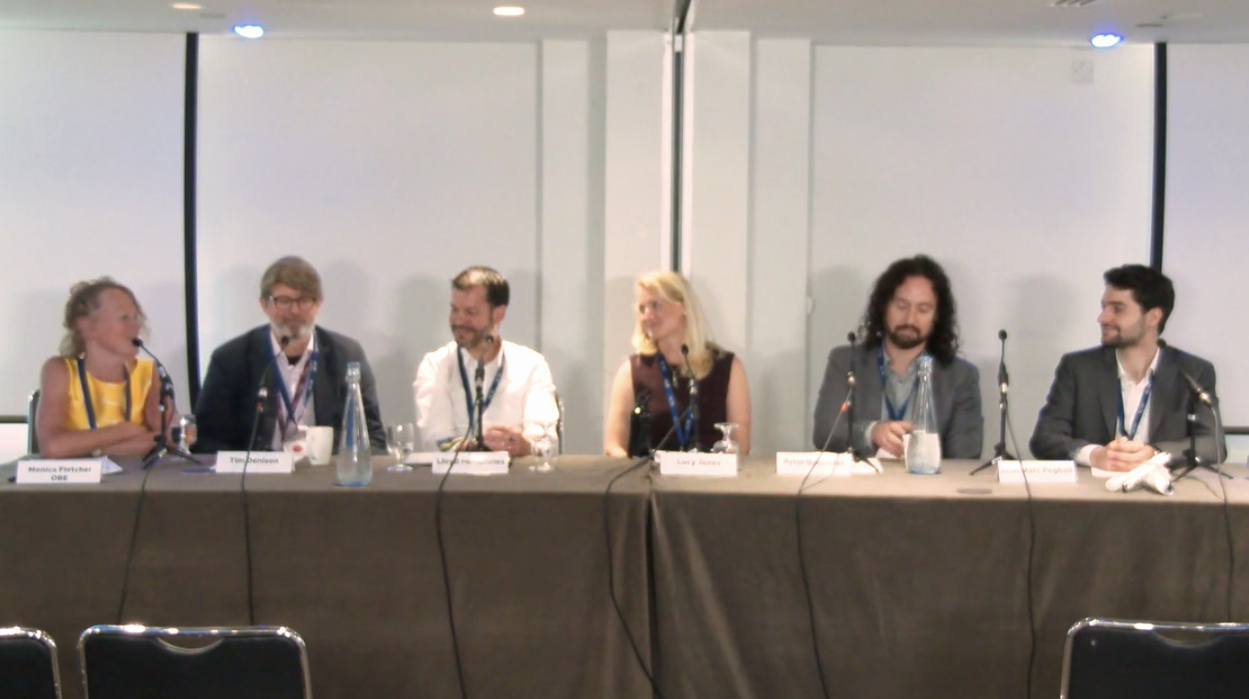
FACILITATED BY
Monica Fletcher OBE | Honorary Research Fellow, Usher Institute | University of Edinburgh
PANELLISTS
Tim Denison | Professor of Engineering Science, Professor of Clinical Neurosciences | University of Oxford
Lloyd Humphreys | Managing Director | Cogniss
Lucy Jones | Vice President Clinical | Oviva
Peter Bannister | Managing Director | Romilly Life Sciences Ltd
Jean Marc Feghali | Head of Research and Development | WeWALK
“It’s not about replacing the human – it’s about augmenting existing services.”
– Session 3, ‘Augmented reality or just a dream?’

FACILITATED BY
Phil Carvil | Head of Clusters (NW) | UKRI Science and Technology Facilities Council
PANELLISTS
Julia Glenn | Design Innovation Lead, Healthy Ageing Challenge Fund | Innovate UK
Caroline Cake | CEO and Co-Founder | Neu Health
Mark Duman | Chief Patient Officer, MD Healthcare | Chief Strategy Officer, Quiddity Health
Mike Lawton | Co-Founder & Director | Oxford Dynamics
With AI dominating conversation across all sectors, Phil Carvil asked how AI and digital technology can improve patient treatment. “We’re seeing many interesting business models,” said Julia Glenn, describing innovators working with NHS clinicians and delivery partners, organisations working to deliver mental health technology to schools, and companies working in the private sector.
The panellists tackled challenges of public hesitance, pace of adoption, and accessibility.
“There is an increasing distrust of AI technology,” said Shefali Sharma, “our idea is to create a hybrid model that supplements the support people need. We still need a human in the loop.”
“Another challenge is the pace at which technology moves – it moves much faster than large organisations such as the NHS,” added Mike Lawton, “by the time solutions are approved and used, the technology has moved on.” On accessibility, Mark Duman commented that “we need to improve digital literacy to ensure tools can reach those in need.”
Caroline Cake outlined three points to consider when adopting digital technologies: “firstly, we must understand the pathway and the intervention we’re trying to address, including patient needs and the clinical pathway. Secondly, we must understand the regulatory environment, the intended use, and evidence needed. And thirdly, we must understand the commercial model – how you’re going to make money.”
“Bringing in people with different backgrounds allows cross-pollination and knowledge sharing.”
– Session 4, ‘It takes a village’
In a sector which, by name, is at the interface of healthcare and technology, Cynthia Bullock led a discussion on multi-disciplinary working. “Innovation requires new ways of thinking,” said Michael Young, referring to ‘the Henry Ford problem’ at the invention of cars: “if you ask people what they want, they’ll say a faster horse. The user doesn’t always know what’s possible.”
Discussing benefits to innovation, Nicola Broughton spoke of the importance of having the right expertise: “innovation happens when you’ve got two people coming together from different angles, bringing knowledge from different disciplines, to come up with something novel.” Kathryn Simpson agreed: “it’s about people with different backgrounds and experiences working together, that’s what drives success.”
Turning to the challenges, panellists highlighted language barriers between disciplines, the need to align values and priorities, and the importance of personality. “The bit that’s often overlooked is balancing personalities,” said Robbie Huddleston. “I invest lots of time in the hiring process to ensure that new hires will complement the existing team. The cost of a bad hire is huge, especially in a small company.”
Finishing with tips to build a strong team, Kathryn alluded to the common scenario where you need specific skills for specific lengths of time: “You can bring specialists in to help with certain stages. It’s important to agree how you’re going to work together in advance so that everyone’s on the same page.”
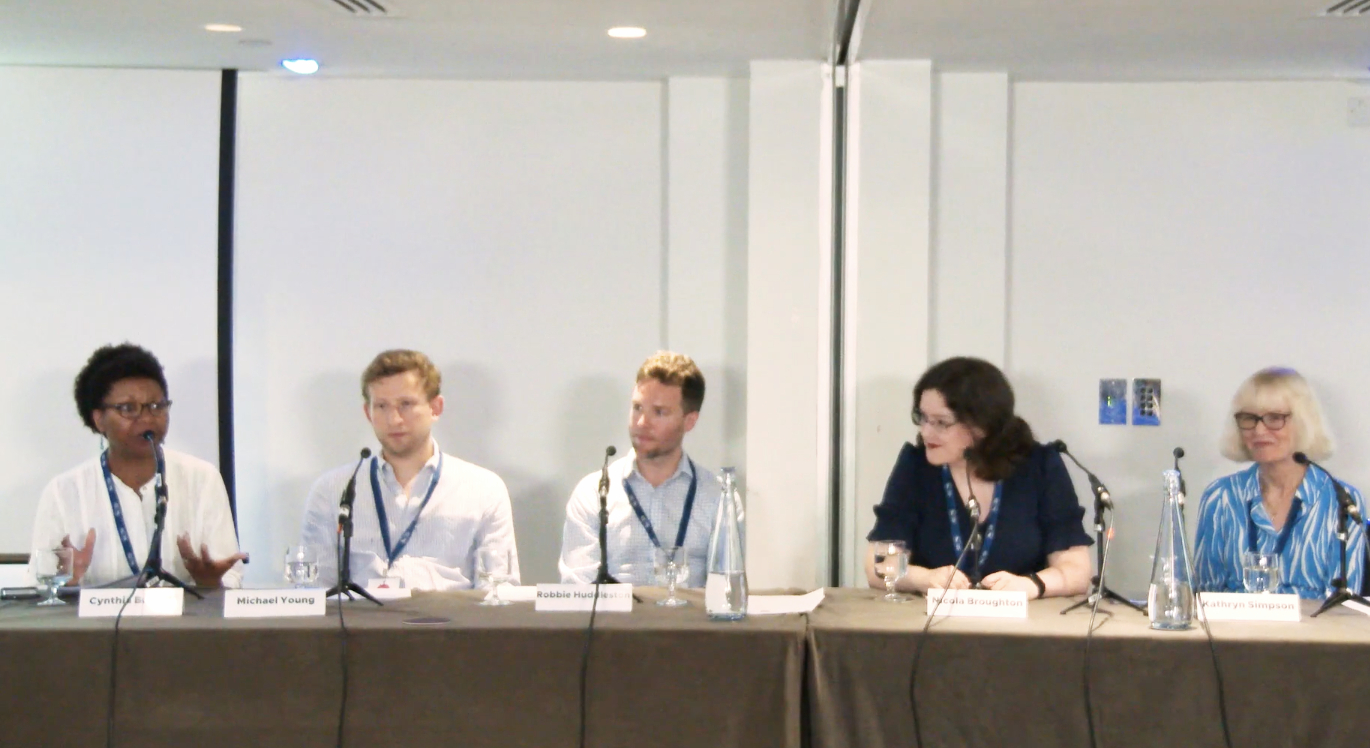
FACILITATED BY
Cynthia Bullock | Deputy Director – Healthy Ageing Challenge | Innovate UK
PANELLISTS
Michael Young | Co-founder | Lindus Health
Robbie Huddleston | Chief Medical Officer | Surgery Hero
Nicola Broughton | Senior Scientist – Device Technology | CPI
Kathryn Simpson | Business Consultant | Kathryn Simpson Consulting Limited
“There are so many wonderful innovations out there, there are so many systems that can reduce the burden on the NHS.”
Innovation at the heart of HealthTech Integrates
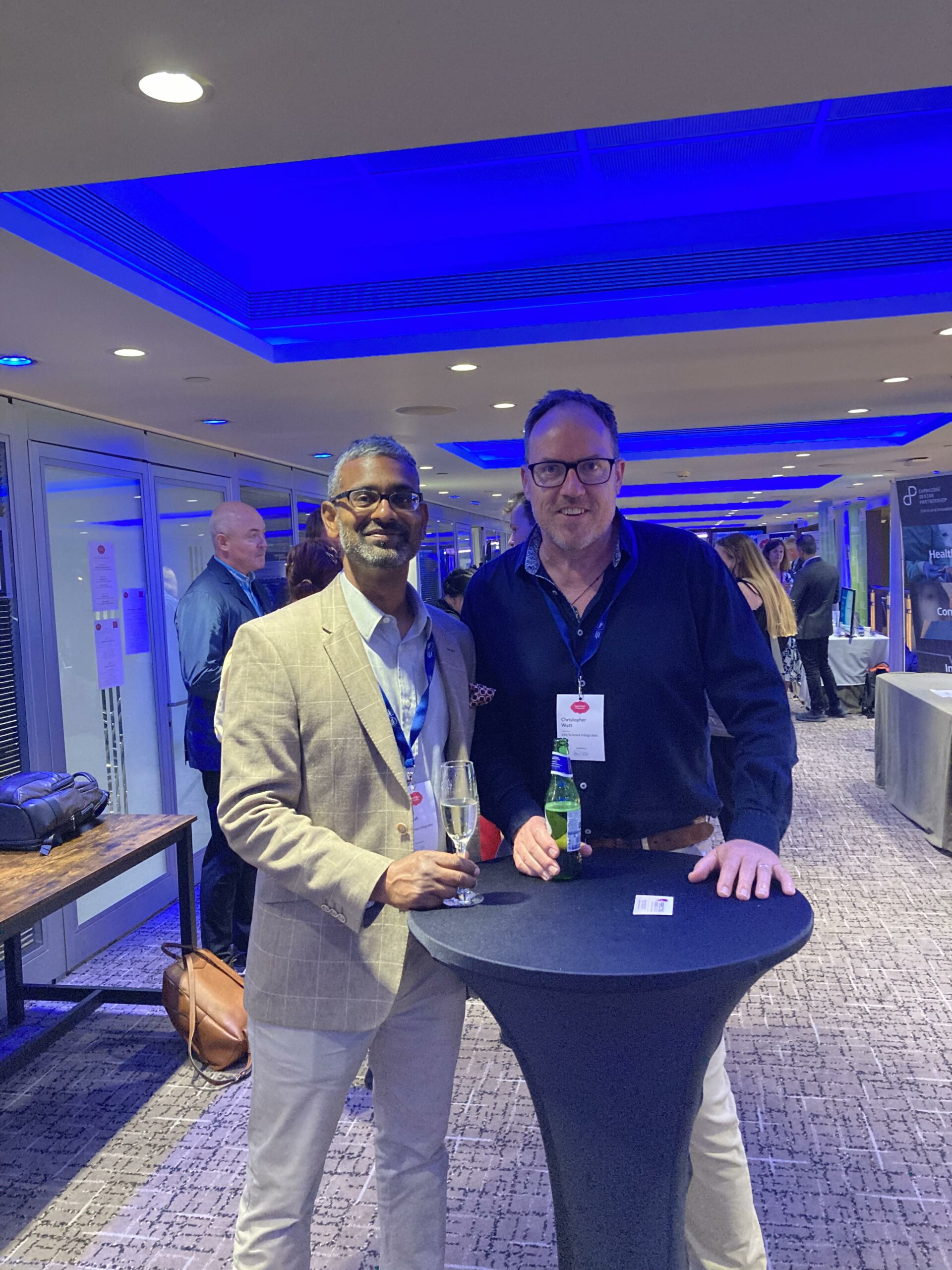
“Thank you to all our speakers, sponsors, and partners who made it possible cover such a wide range of opportunities and challenges in such depth” said Life Science Integrates Executive Director Samuel Thangiah.
“It’s amazing to see the amount of innovation occurring in this sector,” added Christopher Watt, Executive Director, Life Science Integrates. “We’re immensely thankful to Bayer who sponsored the HealthTech Innovator Area, an excellent space that gave innovators and start-ups the opportunity to share their projects, products, and results with delegates across the sector.”
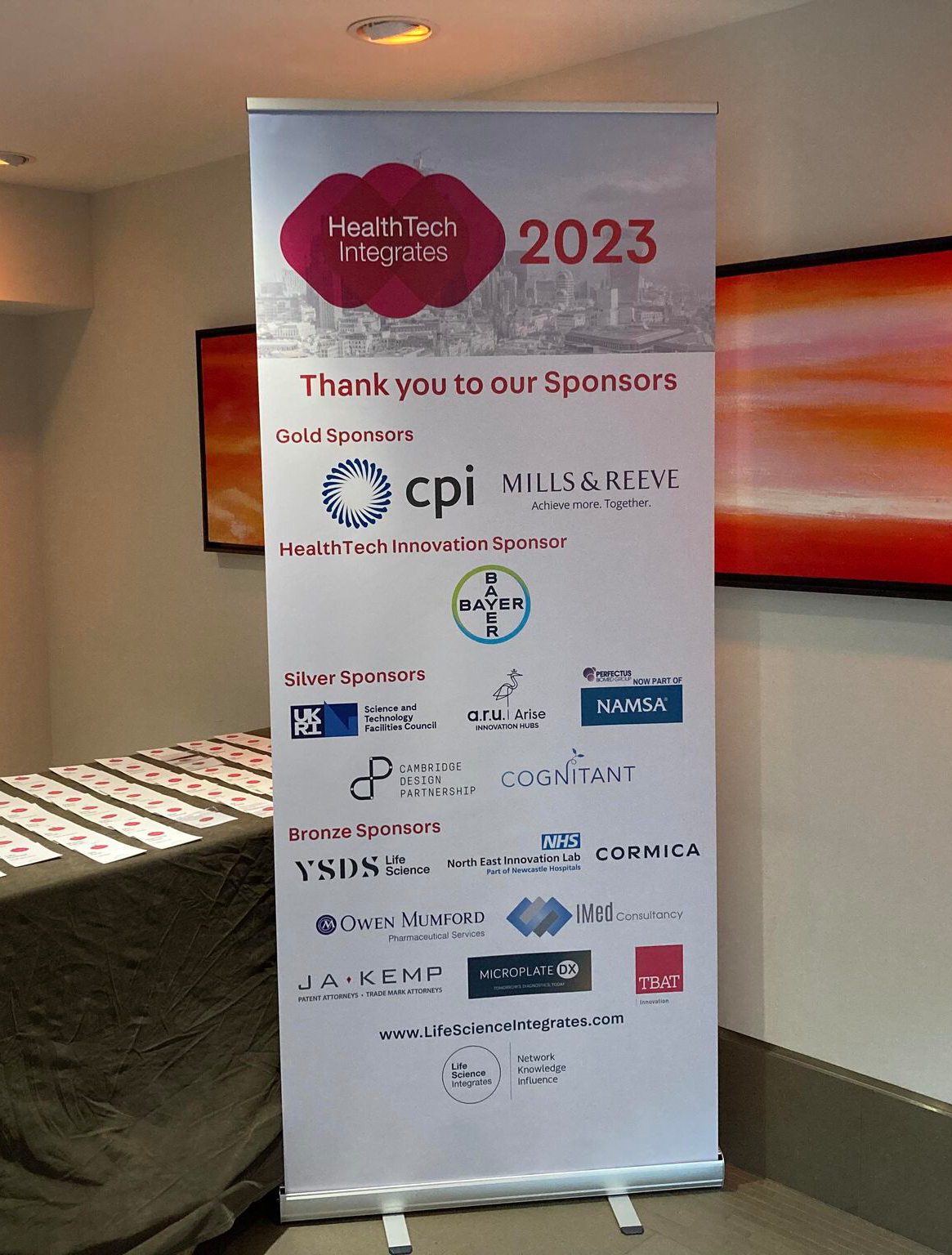
Christopher Watt and Samuel Thangiah, Life Science Integrates
